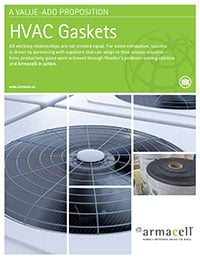
HVAC is an established and regulated industry, which makes it occasionally difficult to find ways to innovate. One of the best ways to be innovative is to optimize your business’s material selection process.
In this guide, the HVAC material experts at Mueller will take you through the factors and questions to consider for choosing the best materials for any application, as well as provide advice for specialized products. With an effective and optimized material selection process, you can create the best products possible.
Material Selection Factors
How Do Common Materials in Insulation Applications Compare to Each Other?
What are the Best Low-Cost Materials for Thermal, Acoustic, Sealing, and Gasketing Applications?
What Are the Best Alternatives to Frame Gaskets?
How Do You Identify, Seal, and Protect Against Conditioned Air Leaks?
How Do You Choose Product Materials Based on UL Flammability Rating?
What are the Best Adhesive Replacements for Mechanical Fasteners?
How Do You Know When to Use Universal & Custom Tube Sizes?
How Can You Cut Costs with Material Selection?
How Do You Choose the Right Materials for Your Application?

What Are the Most Common Materials in Insulation Applications?
The HVAC industry has been around for so long that certain materials have been identified as the best for use in multiple applications. The two most prominent materials for insulating applications are foam and fiberglass, though non-woven materials are currently on the rise.
Fiberglass
Fiberglass is one of the most inexpensive and versatile materials in the HVAC industry. Its thermal and acoustic insulating properties make it a great choice for applications ranging from unit to home insulation. It can also be used in ductwork, taking the place of sheet metal.
Foams
There are three different types of foam used in the HVAC industry, each with their own qualities and applications:
Open-cell foams are primarily used as either environmental filters or acoustic buffers, but can also be placed between a unit’s metal components to reduce vibration and provide acoustic insulation.
Closed-cell foams, such as Poron and silicone, are used mainly in access doors for HVAC units. These foams prevent leaks and moisture issues, as well as offering a degree of noise insulation.
Crushed foam is primarily used as a gap filler in HVAC units because it fills gaps in surfaces that are inconsistent and does so without causing deflection in thin metals or plastics.
Non-Woven Materials
Many companies that produce non-wovens are trying to break into the HVAC market. For the most part, their products are seeking UL testing approval so they can be cleared for use. Non-woven materials have the potential to be excellent thermal and acoustic insulators and are much cleaner non-irritant materials.
Comparing the Materials to Each Other
Choosing the right material for your application hinges on two factors: knowing what the product will do and the specifications it must meet.
The three most important factors to keep in mind are a material’s density, thickness, and flammability rating. Understanding these specifications and how they pertain to your application can help you choose the right insulating product.
.jpg?width=511&name=unnamed%20(19).jpg)
What are the Best Low-Cost Materials for Thermal, Acoustic, Sealing, and Gasketing Applications?
We’ve established that there is a group of common materials used in HVAC applications. However, there are ways to reduce costs for these thermal, acoustic, sealing, and gasketing materials that you might not have considered (and a few that will be familiar).
- In both thermal and acoustic applications, fiberglass is often used for insulation.
- In sealing applications, a blended PVC-NBR sponge material is most commonly used to seal out air.
- For gasketing applications, you can use materials such as silicone and Poron, depending on the temperature and environment.
Fiberglass is an inexpensive and versatile material staple in the HVAC industry for its insulating properties. Blended PVC-NBR sponge is often used as a gap filler for air handlers, often referred to as “stripping.” Meanwhile, silicone and Poron are used in high-temperature environments as gaskets.
Though there are only a handful of commonly used HVAC materials, focusing on the ones with the most value for your particular application is important. By identifying the material that’s best suited for this application, and then assessing your current material specifications and supply chain, you can ensure that you’re getting the best cost possible.
.jpg?width=511&name=Sealedaccesspanel%20(1).jpg)
What Are the Best Alternatives to Frame Gaskets?
Frame gaskets are an essential component of any unit, sealing out dust, debris, moisture, and other environmental factors. However, die-cut frame gaskets are too expensive for many manufacturers due to the wasted material that results from their creation, which is where alternative gasket types come in.
There are four main alternatives to frame gaskets that will give you similar performance, as well as a few upgrades.
Collapsible Gaskets
This gasket type is a frame gasket, but in a collapsed, folded state. These parts look like regular rectangular strips with minor angular cuts that allow the end user to open them and apply them to a component. Collapsible gaskets are half the cost of traditional frame gaskets with identical performance.
Dovetail Strips
Dovetail strips are like frame gaskets broken up into multiple sections for simpler assembly; the application process involves attaching the two different ends together like a puzzle. This gasket type is just as cost effective as collapsible gaskets, while suffering in performance a bit due to the open areas where the pieces don’t meet.
Molded Gaskets
Molded gaskets are almost identical to traditional die-cut frame gaskets. This type of gasket may have a lower piece price as a result of the molding process, but typically has a higher upfront tooling cost due to the cost of the mold itself.
Room Temperature Vulcanizing (RTV) Silicone Caulk
RTV caulk is a low-cost gasketing option best used for low-volume applications; since it’s applied manually, it is often messy and inconsistent. It can be used in gasketing applications, but is better suited for tasks like duct sealing.
As with most material selection, your choice of gasket will depend on the application and the product’s environment. With frame gasket alternatives, all of the seal types discussed will perform similarly with the proper precautions.
.jpg?width=512&name=unnamed%20(24).jpg)
What Can Cause Conditioned Air Leaks and How Do You Identify, Seal, and Protect Against Them?
One of the most common sealing applications in the HVAC industry is protecting products against conditioned air leaks. These leaks have the potential to negatively affect your customer’s living environment, so it’s important to make sure that they are sealed off and prevented. Here are some of the best ways to do so.
Using the Wrong Materials
There are multiple points in the air conditioning process where the wrong materials can cause leaks and other issues.
You need the right type of foam with an appropriate compression set for air-handler access panels and insulation, as these materials can cause gaps or other issues if used incorrectly.
Incorrect Gasketing & Gap Tolerance
Speaking of gaps, they can be created by not accounting for differences in irregular surfaces. If you aren’t using a conformable material, you risk having air gaps in your unit and ductwork.
There are multiple ways to identify an air leak: if a unit is running all the time, if the temperature in the home or office being served is never at the right level, or if the space’s energy bill is too high. When creating these units, it’s important to keep these issues in mind to prevent them from happening.
By finding the right materials to use with air handler components, as well as accounting for factors like gap tolerance, you can prevent conditioned air leaks in your HVAC products and save your customers from reporting issues and discomfort.

How Do You Choose Product Materials Based on Flammability Rating?
Another key consideration for materials in the HVAC industry is flammability rating, which plays a large part in material selection.
Whether you’re accounting for multiple factors or looking to reduce costs, here are some ways you can select the best materials to meet your flammability specifications:
- Unit Location
- Indoor vs. Outdoor Units
- Material Cost
- Adhesive Properties
These factors all affect the material you choose for your products, so it’s crucial to ensure that you meet all the specifications relevant to your product.
There are also a few questions you can ask yourself during the selection process to ensure you make the right choice:
- What is the application?
- Do you have the flexibility to change the chosen flammability rating?
- Is it possible to use a lower flammability rating to meet adhesion properties?
- Are you using a common or blanket spec? Does that spec apply to the product?
Asking these questions and fully understanding your application and its design is invaluable for making the right material decisions when it comes to flammability ratings.

What are the Best Adhesive Replacements for Mechanical Fasteners?
Innovations in the HVAC industry are not common, so when they do come along, it’s important to take note of them.
Shifting from mechanical fasteners to adhesives in certain applications makes a lot of sense: They perform multiple functions simultaneously, decrease assembly time, and create more aesthetically pleasing products.
The two dominant adhesive types used in place of mechanical fasteners are double-coated tape and double-coated foam tape. Both of these tapes are double-sided, come in a variety of thicknesses, are used with a number of carriers, and are suited for attachment to a variety of metal and plastic materials.
There are two main questions you need to ask when selecting a fastener replacement adhesive:
- What two substrates are being attached to one another?
- What environmental factors will affect the adhesive?
The substrates being attached each have their own surface energies, which can affect adhesion levels. The most prominent substrates in the HVAC industry are metals and plastics, each with their own surface energies and requiring different adhesives.
Environmental factors (such as heat, cold, and moisture) should also factor into your decision. Acrylic-based adhesives, in particular, are well-suited for environments where the temperature regularly changes.
You should also consider factors like chemicals or fuel on the substrates, as well as UV rays that can affect adhesive performance. There are more specialized tapes to address these potential issues, so make sure you consider their presence in your products.
.png?width=600&name=pasted%20image%200%20(4).png)
How Do You Know When to Use Universal & Custom Tube Sizes?
Proper tubing is a crucial aspect of any functional HVAC system. If you want your units to remain free of issues like air gaps and freezing pipes, you need to understand the difference between universal and custom tubing.
Reasons to Use Universal Tubes
Universal tubes come standard in six-foot lengths. They have two main wall thicknesses, ⅛-inch and ¼-inch. Of the two, the ⅛-inch thickness is most commonly used in the HVAC industry. They are easy to acquire and very cost effective (often 30% cheaper than custom tubing).
Reasons to Use Custom Tubes
Custom tubes can be customized to meet almost any pipe thickness and come in lengths of 100 feet, 400 feet, and 800 feet. At those lengths, the tubes themselves are cheaper and can be cut to meet specific SKUs. However, custom tubes have high labor costs, making them more expensive overall compared to universal tubes.
The type of tubing you use should be determined by the application and the size of copper piping in the unit. Finding what tube best fits that piping is the most important factor in your decision-making process.
While these two types of tubing do have a lot in common, their differences are important enough to make the distinctions matter.
How Can You Cut Costs with Material Selection?
Ultimately, you want to lower spending and cut costs with your material selection process. Finding the right product for your applications is essential, but so is finding an option within your budget. Let’s examine some ways to reduce spending and select materials a better way.
Don’t Overspecify Materials
It’s common for companies to over-spec materials. If you’re looking to cut costs during the material selection process, spend some time looking at product spec sheets. This will help you make sure that your chosen products aren’t too aggressive or high-level for your application.
Don’t Overspecify Adhesives
You can reduce costs and save money by using the right adhesive for your application. If you’re assembling a product that is going to be mechanically fastened, don’t use an acrylic-based adhesive. They are more expensive than rubber-based adhesives and far too overspecified for that application. Small changes like this will save you and your customers money in the long run.
Switch from Bun to Roll Materials
Many manufacturers are still using old specs to supply their materials. To reduce costs in your material selection process, find alternative materials and make sure they are continuously made in rolls (not in buns). Simply switching from bun materials to rolled materials will save you money without having to completely overhaul your process.
These aren’t massive changes to your material selection process, but ensuring that the products you use are optimized and up-to-date can save your business (and your customers) money in the long run.
How Do You Choose the Right Materials for Your Application?
This guide and its collection of resources is the first step to ensuring that you select the best materials for any HVAC application. The HVAC industry might not be ever-evolving or constantly innovative, but there are still opportunities to make changes to your business and its material selection process.
Making sure you understand your material options, the specifications they need to meet, common applications, areas for improvement, and ways to get the best cost are all important for creating products that meet the needs of both you and your customers. It doesn’t matter if you’re designing entire air conditioning units or crafting ductwork for office space, these factors will affect your products regardless.
Great products start with great materials, and you can use this guide to ensure that you get the best materials available for your application. Take this information and get to work creating better, more effective HVAC products today.




.jpg?width=512&name=unnamed%20(6).jpg)


